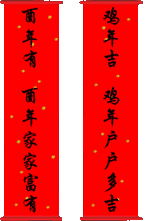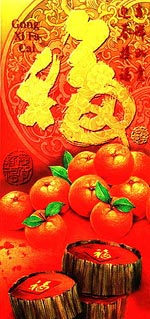|
|
 |
| Home
> Article
> Traditional Celebration of the Chinese New
Year |
| |
| Traditional Celebration
of the Chinese New Year |
| |
 |
| |
The Chinese New Year is perhaps
the most complex, colorful, and important celebration
amongst all the traditional Chinese festivals, which
is celebrated on the first day of the First Moon
of the Lunar Calendar. It is a time for the Chinese
people to congratulate each other and themselves
on having passed through another year, a time to
end the old, and to greet the new year. The Chinese
usually say ‘Guonian’
for having passed the old year, and ‘Bainian’
for congratulating the new year.
The Chinese New Year is also a time for family reunions,
and for visiting friends and relatives. This holiday
indicates the importance of family bonds, and the
Chinese New Year's Eve dinner gathering becomes
one of the most important family occasions of the
year.
Similar to the Western New Year, Chinese New Year
also signifies turning over a new leaf. Preparations
for the Chinese New Year start days before the New
Year's Day. The annual housecleaning or the ‘sweeping
of the grounds’ is done on the 20th
day of the last month. Every corner of the house
must be swept and cleaned to sweep away any traces
of bad luck. Doors and windowpanes are repainted,
usually in red.
 Spring
Couplets, written in black ink on large vertical
scrolls of red paper, are placed on the walls or
on the sides of the gate-ways. These couplets, short
poems written in classical Chinese, are words of
good wishes for the family in the next year. Flowers
and fruits are used to decorate the house, and colorful
new year pictures (Nian Hua)
are put on the walls. Spring
Couplets, written in black ink on large vertical
scrolls of red paper, are placed on the walls or
on the sides of the gate-ways. These couplets, short
poems written in classical Chinese, are words of
good wishes for the family in the next year. Flowers
and fruits are used to decorate the house, and colorful
new year pictures (Nian Hua)
are put on the walls.
After cleaning the house, it is time to wish farewell
to the Kitchen God (Zaowang).
The Kitchen God is regarded as the guardian of the
family hearth. He is regarded as the inventor of
fire, which is needed for cooking and is also the
censor of family morals. By tradition, the Kitchen
God leaves the house on the 23rd
day of the last month to report to Heaven on family’s
behavior. At this moment, the family will do everything
possible to get a positive report from the Kitchen
God. On the evening of the 23rd,
the family will provide the Kitchen God a ritualistic
farewell dinner with sweet foods and honey.
Away from the surveillance of the Kitchen God, who
is supposed to return on the 1st
day of the New Year, the family now is getting ready
for the upcoming celebrations. In old China, the
stores were closed on the last two or three days
of the year and remained closed for the first week
of the New Year. Therefore, families were busy in
the last week of the old year stocking up on foods
and gifts. The Chinese people tend more often to
give food items as gifts, such as fruits and tea.
The last days of the old year is also the time to
settle accumulated debts.
On the final day of the old year, people are busy
either in preparing food for the next two days,
or getting tidied up for the New Year’s Day.
All the foods must be prepared before the New Year’s
Day, so that all sharp instruments such as knives
and scissors can be put away to avoid cutting the
‘luck’ of
the New Year.
On the evening of the New Year’s Eve, all
members of the family will gather for the important
family dinner. Even if a family member cannot attend,
an empty seat will be kept to symbolize that person’s
presence at the banquet. At midnight after the dinner,
the younger members of the family will bow and pay
their respects to their parents and elders.
 On
New Year’s Day, the children are given Red
Envelopes (Lai-See).
It is good fortune money enclosed in little red
envelopes. Red symbolizes fire, which according
to legend, it can drive away bad luck. On New Year’s
Day, people wear new clothes or red clothes, and
put on their best behavior. It is not allowed to
tell a lie, raise the voice, use indecent words,
or break anything on the first day of the new year. On
New Year’s Day, the children are given Red
Envelopes (Lai-See).
It is good fortune money enclosed in little red
envelopes. Red symbolizes fire, which according
to legend, it can drive away bad luck. On New Year’s
Day, people wear new clothes or red clothes, and
put on their best behavior. It is not allowed to
tell a lie, raise the voice, use indecent words,
or break anything on the first day of the new year.
From the second day onwards, people start visiting
friends and relatives, bringing gifts and Lai-See
for the children. Visitors will be greeted with
traditional new year delicacies, such as melon seeds,
flowers, fruits, tray of togetherness, and new year
cakes (Niangao).
The entire first week is a time for socializing
and amusement. There are many lion dances, acrobats,
theatrical shows, and other entertainments. Firecrackers,
which represent pushing away evil spirits, are heard
throughout the first two weeks of the New Year.
They are rooted in a similar ancient custom. Long
ago, people in China lit bamboo stalks, believing
that the crackling flames would frighten evil spirits.
The 7th day of
the New Year is called "everybody’s
birthday" as everyone is considered
one year older since that date. In traditional China,
everyone added a year to his age on New Year’s
Day since individual birthday was considered less
important than New Year’s date.
To mark the end of Chinese New Year celebrations,
the Lantern Festival is held on the 15th
day of the month. Some of the lanterns may be works
of art, painted with birds, animals, flowers, zodiac
signs, and scenes from legend and history. People
hang glowing lanterns in temples, and carry lanterns
into the streets to join in an evening parade under
the light of the full moon.
In many areas, the highlight of the Lantern Festival
is the Dragon Dance. The dragon, which may stretch
a hundred feet long, is typically made of silk,
paper, and bamboo. Traditionally, the dragon is
held up by young men who dance as they guide the
colorful dragon through the streets. The bobbing
and weaving of the dragon is such an impressive
sight, and created a remarkable end of the New Year
Festival. |
| |
| Back
to other articles |
| |
|
 |
|
|
